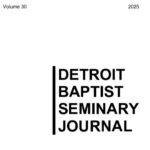Whatever Happened to Literal Hermeneutics? (Part 5)
Having laid out in the previous several posts what I believe may be commended as “received laws of language,” I would like to close this series with a practical look at a pair of difficult passages that stretch the limits of the discussion: Matthew’s use of fulfillment language in 2:15 and 16–18 in citing Hosea 11:1 and Jeremiah 31:15, respectively. Note the following:
| Hosea 11:1—When Israel was a child, I loved him, and out of Egypt I called my son (cf. Exod 4:22–23). | Matthew 2:15—[Joseph stayed in Egypt] until the death of Herod. And so was fulfilled what the Lord had said through the prophet: “Out of Egypt I called my son.” |
| Jeremiah 31:15—This is what the LORD says [of the exiled Israelite community]: “A voice is heard in Ramah, mourning and great weeping, Rachel weeping for her children and refusing to be comforted, because her children are no more.” | Matthew 2:16–18—Herod…gave orders to kill all the boys in Bethlehem and its vicinity who were two years old and under…. Then what was said through the prophet Jeremiah was fulfilled: “A voice is heard in Ramah, weeping and great mourning, Rachel weeping for her children and refusing to be comforted, because they are no more.” |
The tension in both instances is that Matthew appeals to descriptive, historical texts (which ordinarily cannot be “fulfilled”) and appears to assign them a predictive function that does not manifest clearly in the original rendering. Below are four approaches that exegetes have used in their analysis of Matthew’s Gospel. Note that I am not offering a comprehensive list of all possible solutions to the tension here raised, but rather four approaches to the tension:
- The first approach is to read both texts literally and conclude that Matthew is a careless researcher guilty of making egregious citation errors. This is what I’ll call the modernist approach.
- A second approach reads both texts charitably but concludes that the two OT texts in view are not to be seen as literal genres. That is, they are not instances of historie but geschichte, and for this reason are legitimate subjects of etiological manipulation/resignification as the ecclesiastical community develops over time. This is what I will call, for simplicity’s sake, the postmodern approach (though it technically predates postmodernism as a system).
- A third approach avoids the specter of biblical errancy in the preceding options by proposing a new hermeneutical approach: it reads the OT text according to a unique model that is not and cannot be used with any other piece of literature. Specifically, while adherents admit that the two OT passages are instances of accurate, normal, rearward-looking history, they propose that God is using Matthew to progressively divulge a metanarrative imbedded into the OT, known originally and completely only to the divine author, that connects two OT events (exodus and exile) organically with the Bible’s grand Christological or redemptive plot. In this way the reader is now able to fully appreciate these OT texts, thus “fulfilling” or exhausting their divinely-intended meaning. Later revelation is always the definitive court of appeal for interpreting earlier texts, and “literal” OT readings held prior to the arrival of the NT are sometimes flat, incomplete, or even wrong, and can therefore “fall away.” This is my attempt to faithfully represent the typological approach.
Disclaimer: The range of typological approaches circulating today makes it impossible for me to offer a description that satisfies all who self-identify with the model, but I make the attempt anyway, with entirely charitable intent. I apologize to all who take umbrage with my description and welcome correctives.
- A fourth approach attempts to salvage inerrancy not by proposing a new hermeneutical approach, but by suggesting one or more exegetical solutions. For instance, I would argue (with Dyer, Toussaint, and others) that the Greek term πληρόω (to fulfill) has a semantic range broader than that carried by the modern English term “fulfill,” and can reference not only completed prophecy, but also something as mundane as an analogy made after the fact. While this approach denies us the tingle of intrigue and inscrutability that the previous approach offers, its strength is the tacit priority it places on the ordinary laws of language. It assumes that OT meaning is plain-in-itself and (as is the case with every “normal” use of language) that its own local context is the definitive court of appeal for interpretation. It does not deny that a grand biblical metanarrative exists, but affirms instead that this unifying center is to be discovered by ordinary rather than mysterious means. This is what I would call the “literal” approach.
Obviously much more could be said (and has been said) about these texts, but it is hoped that the previous is adequate to identify the basic approaches to the problem that are in circulation today. I also hope that it commends the last approach (often associated with dispensationalism) as a more hermeneutically credible one (i.e., more faithful to the received laws of language) than the typological approach that in the ascendancy today.



I have really appreciated this series of posts. I actually still think that the typological approach is the correct one (though I’m trying to be open-minded).
But these posts have helped me see why (from my current understanding), dispensationalists so often deny the interpretation that Christ and the apostles (seem to) attribute to Old Testament texts.
I see that you have given one of the best-stated and most reasonable arguments for a literal (non-typological) hermeneutic that I have seen.
Thank you.
Brother Snoeberger,
There may be another solution to the Matthew 2:15 passage. Please check John H. Sailhammer, The Pentateuch As Narrative (Grand Rapids: Zondervan, 1992), 408. He points out that Hosea borrowed his language from Balaam’s prophecies in Numbers 23 and 24. In 23:22 Balaam uses the plural “God brought them out of Egypt.” In 24:8 the rebellious prophet used the singular “God brought him forth out of Egypt.” In one passage Balaam is speaking of the nation and in the other passage he speaks of Messiah. The Holy Spirit moved Hosea to use the singular which comes forward to Matthew 2:15. You can check Sailhammer’s statement. I believe he is right at this point.
I just worked through James’ quotation of Amos 9 in Acts 15:15-17. The obvious answer there is that James is quoting the Septuagint.
Dr. Moritz,
Greg Beale takes a similar position in the 55.4 issue of JETS (2012), calling it a typological view, but also trying to show that the practice is more commonplace or “normal” than I have described it.
While this is an advance on earlier typological views, I’m not convinced that the “him” of Numbers 24 commends itself most naturally as a reference to Christ. Some see it as God, others Moses, others a king-figure, and still others a personification of the nation as an individual. You (and Sailhamer and Beale) may be right, but I’m not convinced yet.
Thanks for the interaction, though–it sharpens the discussion. It surely is a difficult text no matter how we look at it.
And this has been an excellent series of articles.
Much appreciate the series… and I’m persuaded of the main idea.
Looking forward to giving it some exposure at SharperIron as well.